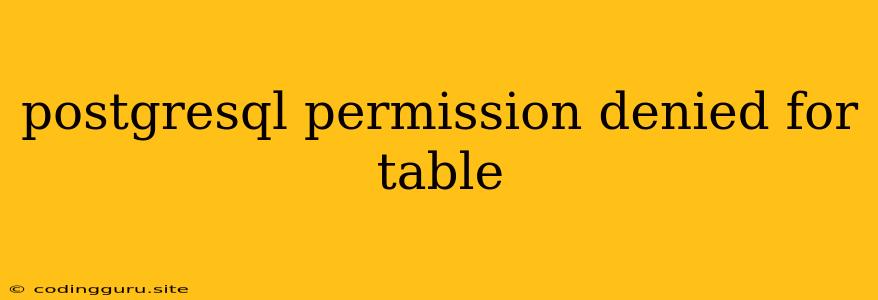Encountering the "permission denied for table" Error in PostgreSQL?
The "permission denied for table" error is a common issue when working with PostgreSQL, often encountered when trying to perform operations like SELECT, INSERT, UPDATE, or DELETE on a table. This error indicates that the user attempting the operation doesn't have the necessary privileges for the specified table.
Here's a breakdown of why this error occurs and how to resolve it:
1. Understanding PostgreSQL Permissions
PostgreSQL employs a robust permission system to control access to databases, tables, and data. The system grants specific privileges to users and roles, allowing them to perform specific actions on database objects. The "permission denied for table" error arises when a user attempts to perform an action that their granted privileges don't allow.
2. Common Causes of the Error
- Incorrect User or Role: The user attempting the operation might be different from the one with the required permissions.
- Insufficient Privileges: The user might have access to the database but lack specific privileges for the table, such as SELECT, INSERT, UPDATE, or DELETE.
- Missing Database Ownership: The user might not own the database containing the table.
- Role Inheritance: If the user's role inherits permissions from another role, the parent role might lack the necessary privileges.
- Table Ownership: The user might not own the table they are trying to access.
3. Troubleshooting Steps
1. Verify User Privileges:
- Check the user's privileges: Use the
\dpcommand inpsqlto list the privileges of the user. - Confirm the user has the required permissions: Ensure the user has the
SELECT,INSERT,UPDATE, andDELETEprivileges on the table.
2. Verify Database Ownership:
- Use
\lcommand: List the databases to identify the owner of the database. - Check ownership: Use the
\dcommand to list the table details and check the table owner.
3. Use the GRANT Command:
- Grant explicit permissions: Use the
GRANTcommand to provide the user with the necessary privileges for the table:GRANT SELECT, INSERT, UPDATE, DELETE ON table_name TO user_name;
4. Re-assign Table Ownership:
- Use
ALTER TABLEcommand: Change the table owner to the user with the desired privileges.ALTER TABLE table_name OWNER TO user_name;
5. Utilize Role Inheritance:
- Create a role with permissions: Define a new role with the required permissions.
- Grant the role to the user: Assign the role to the user needing access.
Example:
Imagine a scenario where a user named "john" attempts to read data from a table named "products" owned by the "admin" role. This user might encounter the "permission denied for table" error. To fix it, grant "john" SELECT privileges on the "products" table:
GRANT SELECT ON products TO john;
4. Best Practices for Permission Management
- Use specific roles: Define distinct roles for different user groups, granting appropriate permissions for their tasks.
- Minimize privileges: Grant users only the permissions they absolutely need.
- Leverage inheritance: Use role inheritance for simplified permission management.
- Regularly review permissions: Periodically check and update user permissions based on changes in application requirements.
5. Conclusion
Understanding PostgreSQL permissions is crucial for securing your database. By following these steps and best practices, you can effectively resolve the "permission denied for table" error and ensure smooth operation of your PostgreSQL applications. Remember to adapt these solutions to your specific needs and environment.
